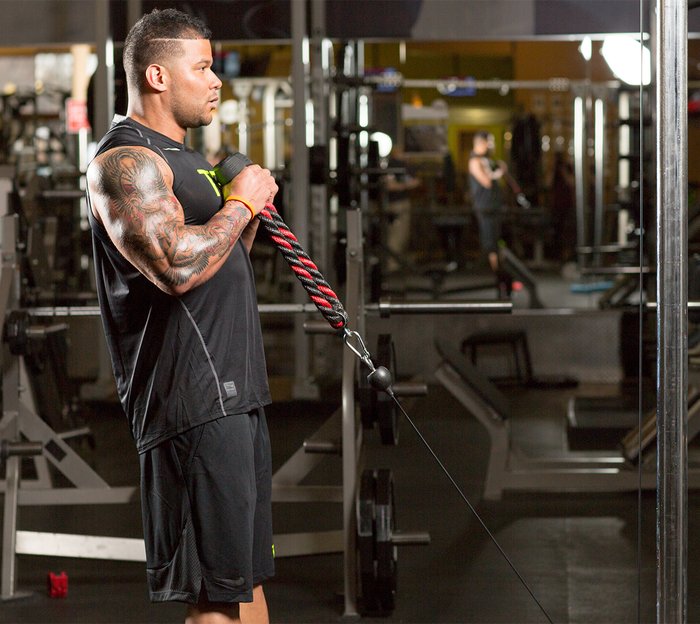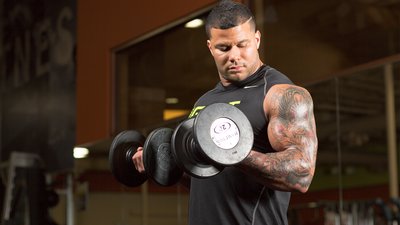Given how much lifters love their arms, you may think that every type of biceps exercise was discovered decades ago. But luckily for you, the quest for new innovation and new ways to stretch sleeves never ends.
Using the same equipment you're using now, you can unlock new growth with just a few simple changes. Get ready to rediscover the joy—and pain—of extended time under tension!
1. Strict Curls and Cheat-centric Curls
Now, before I tell you the right way to cheat-curl some of the time, I have to tell you why you shouldn't cheat most of the time.
At any given time at any gym, you'll see at least one guy doing heavy biceps curls where he has to throw his lower back or legs into it each time he brings the weight up, while also allowing it to come crashing back down. If you don't see that dude at your gym, it may be because he's you!
When you go too heavy, here's what happens:
- You reduce the time under tension because you're forced to use momentum to cheat.
- You're unable to lower the weight in a slow, controlled manner, further reducing your time under tension.
- You're unable to focus on the muscles being worked because you have to struggle just to get the weight up.
- You utilize more muscles, which reduces the accumulated pump in muscles you intend to target—in this case, the biceps.
That said, there was a research study titled "Does cheating pay: the role of externally supplied momentum on muscular force in resistance exercise" that actually made a decent case for cheating![1] The authors found that "a moderate use of external momentum" can actually increase both the peak muscle activation and the total growth stimulus of a lift.

Now, before you accuse me of speaking out of both sides of my mouth, understand that when you use momentum to get a weight up, what you're really doing is a partial rep. And as I discussed in "The 6 Grittiest Chest Exercises You're Not Doing," partials definitely have their place. You just have to make sure they're not replacing your strict full-range-of-motion reps!
So here's the deal: The vast majority of the time, focus on maximizing time under tension by performing full-ROM reps with a controlled, strict concentric phase with a nice, steady eccentric of 3-4 seconds. This is safer for your joints and better for your muscles.
Once you've done your full-ROM work, though, you can occasionally do some cheat-centric curls for dessert. What are these? As I discussed my article "Cheat the Smart Way," this is a rep where you use just a little hip or leg drive to get the weight up—while still keeping your spine neutral. But then, rather than letting the weight come crashing down, you extend the eccentric portion even further—like 4-6 seconds.
These types of slow eccentrics have been shown to produce superior growth over quick lowering, so this is your way of getting the best of both worlds.[2] Without a slow eccentric, you're really only cheating yourself!
2. Cable Curl Mechanical Dropset
All exercises have a point within the range of motion where the exercise is hardest on the muscle involved, commonly known as the sticking point, and other areas within the ROM in which it’s easier. When you do standing barbell curls, that sticking point is when your elbows reach 90 degrees of flexion (when your forearms are parallel to the floor). If you're doing biceps curls using a cable column, the sticking point changes; it’s instead when your forearm reaches a 90-degree bend with the angle of the cable.
One great thing about the cable stack is that you can actually change the point of maximum difficulty—or the point where the lever arm is longest, mechanically speaking—by simply changing where you stand.

To take advantage of this phenomenon, set the cable at its lowest position, and attach an EZ-bar or straight-bar attachment. Step back until the angle of the cable is roughly 45 degrees, or a pure diagonal line. When you curl at this angle, the point of maximal tension will be closer to the top range of motion, where you're weaker.
Once you can't maintain good technique, step forward so you're standing directly in front of the cable and the cable itself is almost vertical. This will move the point of maximal mechanical tension closer to the mid-range of motion, where you're likely stronger. You'll work more of your biceps in less time and definitely give them a novel stimulus in the process.
Of course, both of these variations also work well as standalone exercises. That said, if you're doing this as a mechanical dropset, try to find a weight load that allows you to perform around 8-10 reps of each version. You may have to adjust the weight load between each variation in order to accomplish that rep range on each.
3. Low Cable Face-Away Biceps Curls
Research has demonstrated that stretching your muscles while they're being activated is one of the most effective ways to stimulate gains in muscle size.[3] That said, aside from preacher curls, most other biceps exercises don't effectively load the biceps from the lengthened position. However, low cable face-away curls get the job done!

Grab one or two cable handles that are positioned low, walk out about a foot in front of the stack, and perform curls while facing away from the cable and keeping your elbows by your sides.
Due to the force vector involved, which I discussed in the previous section, this unique exercise makes the hardest part of the curl the bottom position, where your elbows are fairly straight.
4. Biceps Curl Machine PGE Sets
Machines get a bad rap, but in the case of the biceps-curl machine, it's not warranted. In fact, this machine offers one advantage that all free weight and even cable-biceps-curl variations can't match: They are all limited to a single load vector—or a single point of maximum difficulty. When you're not at that point, your biceps are working less. That's precisely why people tend to rest between reps at the top and bottom position when doing barbell or dumbbell curls.

On the other hand, the biceps curl machine is designed with a cam system, which isn't dependent on a single load vector like free weights or cables. Instead, the CAM offers consistent resistance throughout the entire range of motion. This also gives you much more time under tension, because your biceps never get a chance to rest at the bottom or top position.
Sure, you can use a variety of different biceps exercises using free weights and cables to create a maximal force angle at different points in the range of motion. But if you're short on time, or looking to add in a "big bang for your buck" move, the preacher-curl machine is an exercise that hits the muscle from all points of the elbow-flexion range.
Want to take full advantage of the strengths of this machine? Perform pause-go-eccentric (PGE) sets, which I explained in my video "The Gritty Workout Your Upper Body Needs." Here's how to perform them: Start by holding your elbows bent at 90 degrees for 8-10 seconds. Then, perform 8-10 full-ROM reps. And finally, on the last rep, extend the eccentric portion of the rep for 8-10 seconds. A couple rounds of this will definitely get your biceps' attention!
5. Thumb-Side Rotating Biceps Curls
Your biceps don't just flex your elbow; they also are a supinator (outward rotator) of your forearm. So, if we want to achieve maximal biceps recruitment when performing biceps curls with either a dumbbell or cable, we must do so in a manner that involves both elbow flexion and forearm supination. This can be achieved by holding the handle in a unique way, but further emphasized by how you perform the curl.

Instead of gripping the dumbbell from the middle in the traditional manner, grip it all the way to the thumb side with your hand as far to this side as possible.
This small change in hand positioning makes a huge difference, because this grip forces you to resist forearm pronation (inward rotation) while you also use them as elbow flexors to perform the curl.
To further emphasize the effect and use your biceps to their fullest potential, perform the curls this way: Once you hit 90 degrees on the way up, think about touching the bottom (pinky side) of the dumbbell to the front of your shoulder on every rep.
6. Updated Biceps 21s
Biceps 21s are an old-school bodybuilding technique that use partial reps and a long time under tension to overload the muscle. In the classic version, you perform 7 top-range partial reps, 7 low-range partial reps, and 7 full-ROM reps.

These are great, but we can further upgrade them by spending more time in the mid range of motion, where tension is greatest, and by incorporating the biceps' supination function that we just discussed.
New Biceps 21s: Version 1
Perform this protocol using dumbbells, a barbell, or with an EZ-bar.
- 7 reps: Mid-range partial reps
- 7 seconds: Isometric hold at 90 degrees, pronating and rotating wrists (dumbbells only)
- 7 reps: Full ROM
Expect to be amazed by how hard these are. That's plenty of time under tension—which means plenty of stimulus to grow!
References
- Arandjelović, O. (2013). Does cheating pay: the role of externally supplied momentum on muscular force in resistance exercise. European Journal of Applied Physiology, 113(1), 135-145.
- Pereira, P. E. A., Motoyama, Y. L., Esteves, G. J., Quinelato, W. C., Botter, L., Tanaka, K. H., & Azevedo, P. (2016). Resistance training with slow speed of movement is better for hypertrophy and muscle strength gains than fast speed of movement. International Journal of Applied Exercise Physiology, 5(2), 37-43.
- Schoenfeld, B. J. (2010). The mechanisms of muscle hypertrophy and their application to resistance training. The Journal of Strength & Conditioning Research, 24(10), 2857-2872.

